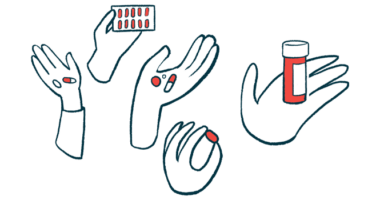1 in 4 patients with epilepsy may stop Epidiolex due to side effects
Dravet, other patients also report lack of efficacy in real world: Study

Up to 1 in 4 people with hard-to-treat epilepsy, including those with Dravet syndrome, were found to stop taking Epidiolex (cannabidiol) shortly after starting treatment, primarily due to side effects or a lack of efficacy, according to a real-world study.
“Epidiolex is generally well-tolerated and the majority continued long-term treatment,” researchers wrote, but noted that the data suggest that most patients who discontinued the therapy did so “within the first several months of treatment.”
“Further studies designed to evaluate early identification and potential mitigation of adverse [side] effects … are warranted,” the team wrote, adding that more research is needed to confirm these findings.
The study, “Real-world, long-term evaluation of the tolerability and therapy retention of Epidiolex (cannabidiol) in patients with refractory epilepsy,” was published in the journal Epilepsy & Behavior.
Early discontinuation of Epidiolex mainly due to side effects
In people with epilepsy, problems in the functioning of the brain cause bursts of uncontrolled electrical activity called seizures. These events can lead to a wide range of mild to severe symptoms that in Dravet patients may present as developmental and cognitive delays, movement problems, and difficulties speaking and sleeping.
Anti-seizure treatment can help most people with epilepsy have fewer of these episodes. However, the various available medications do not work well for everyone, in which case patients are said to have refractory or hard-to-treat epilepsy.
Epidiolex is an oral medication that contains highly purified cannabidiol, a compound found in the cannabis plant that mimics the body’s natural compounds. It acts on seizure-regulating brain receptors to prevent such episodes from occurring.
The therapy is approved in the U.S., in Europe — where it’s sold as Epidyolex — and in other regions as an add-on treatment to prevent seizures in children and adults with treatment-resistant forms of childhood-onset epilepsy. These conditions include Dravet, Lennox-Gastaut syndrome, known as LGS, and tuberous sclerosis complex, called TSC.
While exactly how Epidiolex works remain unknown, the therapy was shown in clinical trials to reduce seizures in children with these disorders. Treatment also has been seen to lead to improvements in cognition, speech, and emotional and social functioning in both pediatric and adult patients.
Previous trial data suggested Epidiolex can cause several potential therapy-limiting adverse effects or side effects, such as diarrhea, liver enzyme increases (a sign of liver damage), decreased appetite, somnolence or sleepiness, and sleep problems. The results also indicated that treatment interactions with certain medications may be therapy-limiting for some patients.
Now, a team of researchers at the University of Wisconsin-Madison, in the U.S., evaluated the long-term effectiveness of Epidiolex. The focus was on a combination of efficacy and tolerability in people with refractory epilepsy in a real-world setting.
The study included 108 patients seen at the researchers’ center and who took Epidiolex for at least two weeks between December 2018 and December 2020.
Most of them (79.6%) had LGS. Five of the patients (4.6%) had Dravet, and three (2.8%) had TSC. The remaining 14 patients (13%) did not have a specific diagnosis for their refractory epilepsy and were using Epidiolex off-label.
The patients ranged in age from 2 to 63, with a mean age of 20.3 years. A little more than half (52.8%) were female. On average, the patients took a starting dose of Epidiolex of 5.3 mg/kg/day, which was increased to a mean 15.3 mg/kg/day over time.
Most patients — 76.9% or 83 in total — were still taking the therapy at their last follow-up, with an average treatment duration of 20 months. This proportion was about the same among children (77.2%) and adults (76.5%) and across the three diseases: 77.9% of LGS patients, 80% of Dravet patients, and 66.6% of TSC patients.
Patients were most vulnerable to therapy discontinuation in months 1–4 (due to side effects) and months 12–15 (due to lack of efficacy).
However, 25 patients (23.1%) stopped taking Epidiolex after an average of seven months.
“Patients were most vulnerable to therapy discontinuation in months 1–4 (due to side effects) and months 12–15 (due to lack of efficacy),” the researchers wrote.
Some Epidiolex side effects linked to clobazam in study
The most common reason for discontinuing treatment was a lack of effectiveness, as reported in about 40% of cases. That was followed by an increase of the number of seizures, worsened behavior, and feeling sleepy or dizzy, which each affected just less than one-quarter of patients.
“Half of the patients who discontinued Epidiolex due to sleepiness, drowsiness, and sedation were taking it concurrently with clobazam,” the researchers wrote, noting that this combination of anti-seizure medications has been suggested to increase the risk of these events.
In addition, 81% of patients who reported this type of adverse events also were taking clobazam.
In contrast to what was reported in clinical trials, treatment discontinuations rarely occurred due to diarrhea (two patients) or liver enzyme elevations (one patient).
Overall, the side effects were similar to what was seen in clinical trials. The most common side effects were sleepiness or drowsiness (16.6%), followed by sleeping difficulties (6.5%).
Patients who experienced aggression, anger, and/or agitation before starting Epidiolex were about twice as likely to stop treatment than those who did not experience behavioral challenges (16% vs. 8.4%).
At the study’s start, almost half (47.2%) of patients were taking clobazam. Some of them — about 40% — were able to decrease their clobazam dose, suggesting that Epidiolex may have helped in reducing the need for the anti-seizure medication.
“When patients had their clobazam dose lowered, they were more likely to remain on [Epidiolex],” the researchers wrote.
Importantly, more than half of patients (53%) were able to decrease the dose of at least one other anti-seizure medication or stop taking it altogether.
These real-world findings highlight that Epidiolex is generally well-tolerated and effective for refractory epilepsy, the researchers noted. But they said more research is needed to better understand the therapy’s side effects and how to improve how well it works.
“Further studies designed to evaluate early identification and potential mitigation of [side effects], including drug interactions, are ongoing,” the team wrote.








